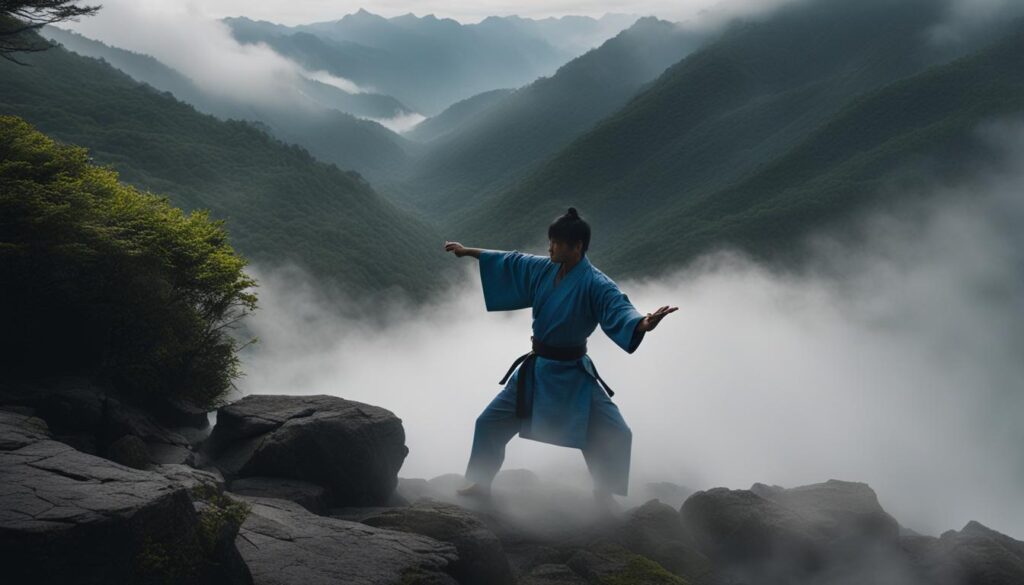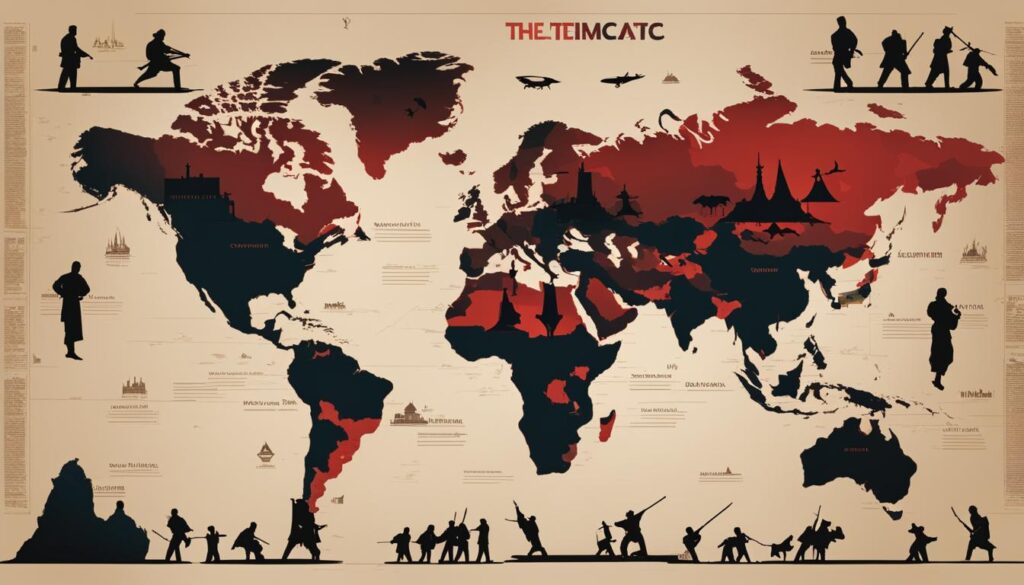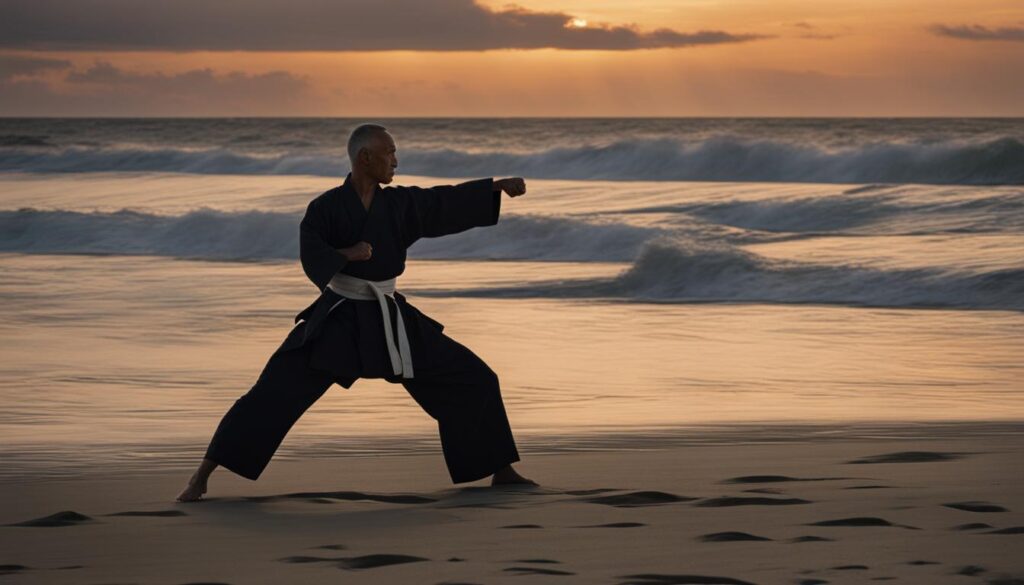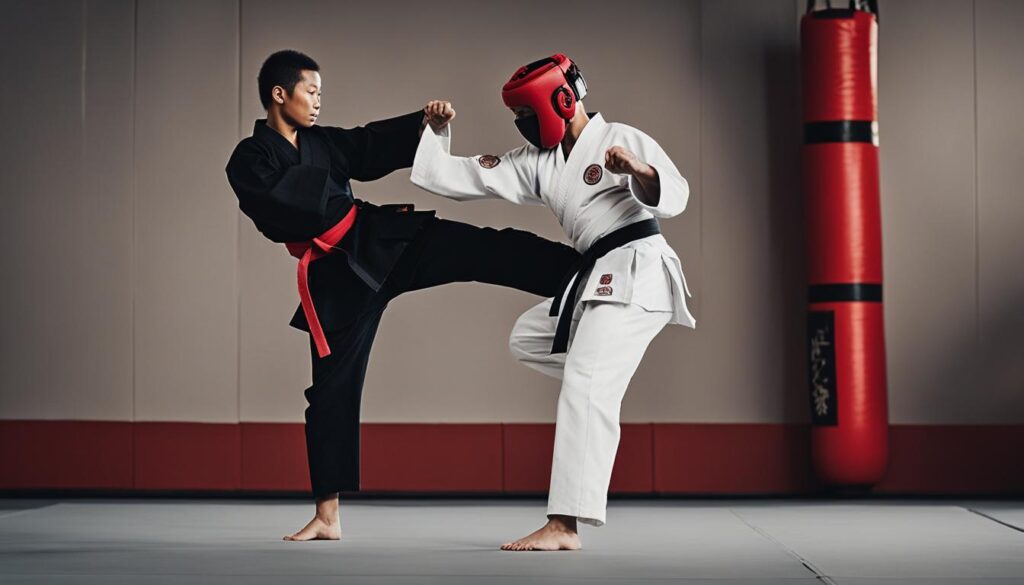Karate, also known as Karate-do, is a martial art that has captivated enthusiasts worldwide with its rich history and cultural significance. But where is this fascinating martial art form from? Let’s dive into the roots of Karate and uncover its origin.
Karate originated in the Ryukyu Kingdom, which is present-day Okinawa, Japan. The art developed from indigenous martial arts of the Ryukyu Islands, influenced by Chinese martial arts like Fujian White Crane. Over time, it evolved into a striking art that incorporates a variety of techniques such as punches, kicks, knee strikes, elbow strikes, and open-hand techniques.
Key Takeaways:
- Karate originated in the Ryukyu Kingdom, which is present-day Okinawa, Japan.
- It developed from indigenous martial arts influenced by Chinese martial arts, such as Fujian White Crane.
- Karate is a striking art that involves a range of techniques, including punches, kicks, knee strikes, elbow strikes, and open-hand techniques.
The Evolution of Karate Styles
Over the years, various styles of karate have developed, showcasing the evolution of this martial art. Early styles of karate, such as Shuri-te, Naha-te, and Tomari-te, originated from different cities in Okinawa, each with its own unique techniques, principles, and kata (forms). These styles laid the foundation for the diverse range of karate practices seen today.
Anko Itosu was an instrumental figure in the evolution of karate styles. He simplified the kata and introduced them to Okinawa’s public schools. This move democratized karate and made it accessible to a wider audience. Gichin Funakoshi also played a significant role in spreading karate beyond Okinawa. He established the Shotokan style, which became one of the most renowned and influential karate styles in mainland Japan and beyond.
Today, practitioners can choose from a multitude of karate styles, each with its own unique characteristics. Some prominent styles include Shotokan, Goju-ryu, Wado-ryu, and Shito-ryu. These styles differ in their emphasis on technique, power, speed, and overall approach to karate.
The evolution of karate styles reflects the adaptation and growth of this martial art as it journeyed from its origins in Okinawa to becoming a globally practiced discipline.
Note: The image above showcases practitioners demonstrating different karate styles.
The Philosophy and Principles of Karate
Karate encompasses a unique philosophy that goes beyond physical combat. It is rooted in traditional martial arts and Japanese martial arts, reflecting a deep cultural heritage.
Discipline and Respect:
Karate emphasizes discipline and respect as core principles. Practitioners are expected to show respect for their instructors, training partners, and the art itself. This fosters an environment of mutual respect and appreciation.
Mind-Body Connection:
Karate recognizes the importance of the mind-body connection. Through rigorous training, practitioners develop physical strength, agility, coordination, and mental focus. This integration of mind and body enhances performance and cultivates a sense of harmony.
Self-Defense and Continuous Improvement:
Self-defense is a fundamental aspect of karate. Practitioners learn various techniques and strategies to protect themselves and others. Additionally, karate promotes continuous improvement, encouraging practitioners to strive for personal growth and mastery of their skills.
Stress Reduction and Mental Fortitude:
Karate provides a means of stress reduction and mental fortitude. The practice allows individuals to channel their energy, reduce tension, and improve overall well-being. Mental strength and resilience are cultivated through the challenging physical and mental demands of karate.
Overall, karate embodies the philosophy of traditional martial arts and Japanese martial arts. Its principles of discipline, respect, mind-body connection, self-defense, and continuous improvement reflect the profound values ingrained in this ancient art form.

| Key Principles of Karate | Explanation |
|---|---|
| Discipline and Respect | Karate emphasizes discipline and respect as core principles. Practitioners are expected to show respect for their instructors, training partners, and the art itself. |
| Mind-Body Connection | Karate recognizes the importance of the mind-body connection. Through rigorous training, practitioners develop physical strength, agility, coordination, and mental focus. |
| Self-Defense and Continuous Improvement | Self-defense is a fundamental aspect of karate. Practitioners learn various techniques and strategies to protect themselves and others. Additionally, karate promotes continuous improvement, encouraging practitioners to strive for personal growth and mastery of their skills. |
| Stress Reduction and Mental Fortitude | Karate provides a means of stress reduction and mental fortitude. The practice allows individuals to channel their energy, reduce tension, and improve overall well-being. Mental strength and resilience are cultivated through the challenging physical and mental demands of karate. |
The Cultural Significance of Karate
Karate holds a profound place in Japanese culture and serves as a testament to the country’s rich cultural heritage. It embodies values that are deeply cherished in Japanese society, such as humility, perseverance, and integrity. However, karate is much more than just a physical practice; it serves as a gateway into Japanese traditions and values, offering a holistic approach to personal development.
An integral part of karate’s cultural significance lies in its emphasis on etiquette and ritualistic practices. Practitioners are encouraged to demonstrate respect not only to their instructors but also to fellow students and the art itself. This emphasis on respect promotes a sense of discipline and camaraderie among practitioners from diverse backgrounds.
Through karate, individuals gain deeper insights into Japanese traditional martial arts and cultivate a respect for the historical roots of the practice. The integration of cultural customs adds depth and meaning to the art, making it a reflection of Japanese society as a whole.
In addition, karate serves as a bridge between different generations and fosters intergenerational harmony. It allows for the transmission of knowledge, values, and wisdom from older generations to younger ones—a seamless exchange that helps preserve cultural heritage and create a sense of continuity.
Karate’s Global Reach
Karate’s journey from Okinawa to the world began in the early 20th century when prominent masters like Gichin Funakoshi introduced the art to mainland Japan. It was systematically taught in Japan and gained popularity among universities and military personnel. The martial arts movies of the 1960s and 1970s further increased the global popularity of martial arts, leading to the establishment of karate schools (dōjōs) worldwide. Today, karate is practiced by millions of people globally, making it one of the most popular martial arts. Karate’s inclusion as an Olympic sport in 2021 further solidifies its global reach and recognition.

The Origins of Karate in Okinawa
Karate, a renowned martial art, can trace its roots back to the Ryukyu Kingdom in Okinawa, Japan. The development of karate can be attributed to the indigenous people of the Ryukyu Islands, who, in the 14th century, devised unarmed self-defense techniques called “te.” This was a direct consequence of political instability and the kingdom’s ban on weaponry.
The history of karate took a pivotal turn when Chinese martial arts, particularly Kung Fu, entered the scene. Chinese traders and emissaries brought their combat techniques to Okinawa, where they blended harmoniously with the local traditions. This fusion eventually gave rise to the unique martial art known worldwide as karate.
Okinawa became a hub where various styles and techniques mingled, leading to the emergence of diverse karate schools. This melting pot of influences contributed significantly to the evolution and refinement of the art form.
The origins of karate in Okinawa serve as a testament to the rich cultural heritage and multi-faceted nature of the martial arts. The fusion of indigenous practices and Chinese influences created a powerful and effective fighting style that has captivated practitioners across the globe.
The Etymology of Karate
The name “karate” has its roots in the Chinese language, originally translated as “Chinese hand” in Kanji. This association reflects the influence of Chinese martial arts on the development of karate in its early stages. However, as relations between China and Japan grew tense, the spelling and meaning of karate underwent a transformation.
The spelling of karate was altered to mean “empty hand,” emphasizing the art’s focus on unarmed techniques. This change in name highlights the evolution and unique characteristics of karate as it developed in Japan. The etymology of karate sheds light on the historical and cultural aspects of Japanese-Chinese relations and their influence on martial arts.
The modification of the name karate was not merely a linguistic adaptation but also a reflection of the political and cultural context of the time. By emphasizing “empty hand,” karate came to represent a martial art that relied solely on the body’s capabilities, devoid of weapons or external aids.
With this new spelling and meaning, karate adopted a philosophy centered around self-defense and personal growth. It became not just a method of combat but also a means of cultivating discipline, focus, and self-improvement. The etymology of karate captures the essence of its evolution as a martial art deeply embedded in Japanese culture.
Next, we will explore the further evolution of karate on the Japanese mainland and its global reach.
Karate’s Evolution on the Japanese Mainland
Gichin Funakoshi, a prominent figure in the history of karate, played a pivotal role in the art’s evolution on the Japanese mainland. Following the annexation of Okinawa by the Empire of Japan in 1879, karate gained exposure to a wider Japanese population. Funakoshi, along with other masters, saw an opportunity to introduce karate to mainland Japan, leading to its widespread recognition and practice.
To make karate more acceptable and align it with other Japanese martial arts, Funakoshi made several significant changes. One crucial modification was the renaming of karate to emphasize its focus on unarmed techniques. By changing the name, he highlighted the art’s distinctive emphasis on using the body as a weapon, without the aid of external tools or weapons.
Focusing on the cultural integration of karate, Funakoshi introduced elements of Japanese culture to the practice. This included wearing white kimonos, a symbol of purity and respect, during training sessions and introducing colored belt ranks to denote progress and mastery. These modifications helped to establish karate on the Japanese mainland as a unique form of martial arts, distinct from other traditions.

The efforts of Gichin Funakoshi not only popularized karate but also paved the way for its further development and recognition as a respected martial art. His dedication to promoting karate as a valuable practice for physical, mental, and spiritual growth has had a lasting impact, shaping the future of the art and inspiring generations of practitioners in Japan and beyond.
The Philosophy of Karate
Karate is not just a physical combat system; it embodies a philosophical approach that extends beyond the sheer act of fighting. Gichin Funakoshi, one of the pioneers of modern karate, emphasized the importance of purging selfish and evil thoughts, fostering a clear mind and conscience in order to truly understand the knowledge imparted through karate.
The philosophy of karate draws influences from various sources, including Buddhist philosophy. The concept of emptiness, which is deeply rooted in Buddhist teachings, has had a significant impact on the philosophical underpinnings of karate. It emphasizes the need to let go of ego and attachments and to cultivate a sense of oneness with the surroundings.
At its core, the philosophy of karate promotes personal growth, self-discipline, and the cultivation of values such as respect, humility, and perseverance. It encourages practitioners to strive for continuous improvement, both on and off the mat, in order to become better versions of themselves.
Through guided training, individuals develop not only physical strength, agility, and coordination, but also mental focus, resilience, and a strong sense of self. The principles of karate act as guiding lights, helping practitioners navigate their lives with integrity, discipline, and respect for others.

The philosophy of karate is not limited to the dojo. It has the power to positively influence various aspects of one’s life, fostering a sense of balance, harmony, and well-being.
Next, we will explore the cultural significance of karate and its deep-rooted connection to Japanese heritage, providing a broader context for understanding the art form.
Conclusion
Karate’s origins in Okinawa and its subsequent evolution on the Japanese mainland have contributed to its global reach and cultural significance. This martial art, rooted in the indigenous traditions of Okinawa, has fascinated martial arts enthusiasts worldwide. What sets karate apart is not just its physical techniques but also its philosophy of self-discipline, respect, and continuous improvement, which resonates with practitioners seeking personal growth.
Throughout its history, karate has adapted and evolved, blending different martial arts traditions and embracing diverse cultures. From its humble beginnings in Okinawa to its inclusion as an Olympic sport, karate has captured the hearts of millions. Its universal appeal is evident in the countless dojos spread across the globe, where individuals of all ages and backgrounds gather to practice this revered art form.
Karate’s significance extends beyond physical fitness and self-defense. It embodies a rich cultural heritage, emphasizing values like humility, perseverance, and integrity. As practitioners delve deeper into the art, they discover the integration of mind and body, finding mental focus and inner peace. Karate’s legacy is the preservation of Japanese traditions and the promotion of personal growth through physical and mental discipline.
FAQ
Where did karate originate from?
Karate originated in the Ryukyu Kingdom, which is present-day Okinawa, Japan.
What are the different styles of karate?
There are numerous karate styles practiced worldwide, each with its own unique characteristics. Some popular styles include Shotokan, Goju-Ryu, Wado-Ryu, and Shito-Ryu.
What are the core principles of karate?
The core principles of karate include discipline, respect, the mind-body connection, self-defense, and continuous improvement.
Why is karate culturally significant?
Karate is deeply ingrained in Japanese culture and serves as a symbol of the country’s cultural heritage. It promotes values of humility, perseverance, and integrity, which are highly regarded in Japanese society.
How popular is karate globally?
Karate is practiced by millions of people worldwide, making it one of the most popular martial arts. Its inclusion as an Olympic sport in 2021 further solidifies its global reach and recognition.
Where did karate originate in Okinawa?
Karate traces its roots to the Ryukyu Kingdom in Okinawa, Japan.
What does the term “karate” mean?
The term “karate” originally translated to “Chinese hand” in Kanji, reflecting its Chinese origins. However, as Sino-Japanese relations became tense, the spelling and meaning of karate changed to mean “empty hand,” emphasizing its focus on unarmed techniques.
Who played a pivotal role in the evolution of karate on the Japanese mainland?
Gichin Funakoshi played a pivotal role in the evolution of karate on the Japanese mainland. He introduced karate to mainland Japan and helped popularize it as a unique form of martial arts.
What is the philosophy of karate?
The philosophy of karate promotes personal growth, self-discipline, and the cultivation of values like respect, humility, and perseverance.
What is the summary of karate?
Karate has a rich history and cultural significance, originating in Okinawa and spreading globally. It embodies core principles of discipline, respect, and continuous improvement, while also serving as a pathway to understanding Japanese traditions and values.
